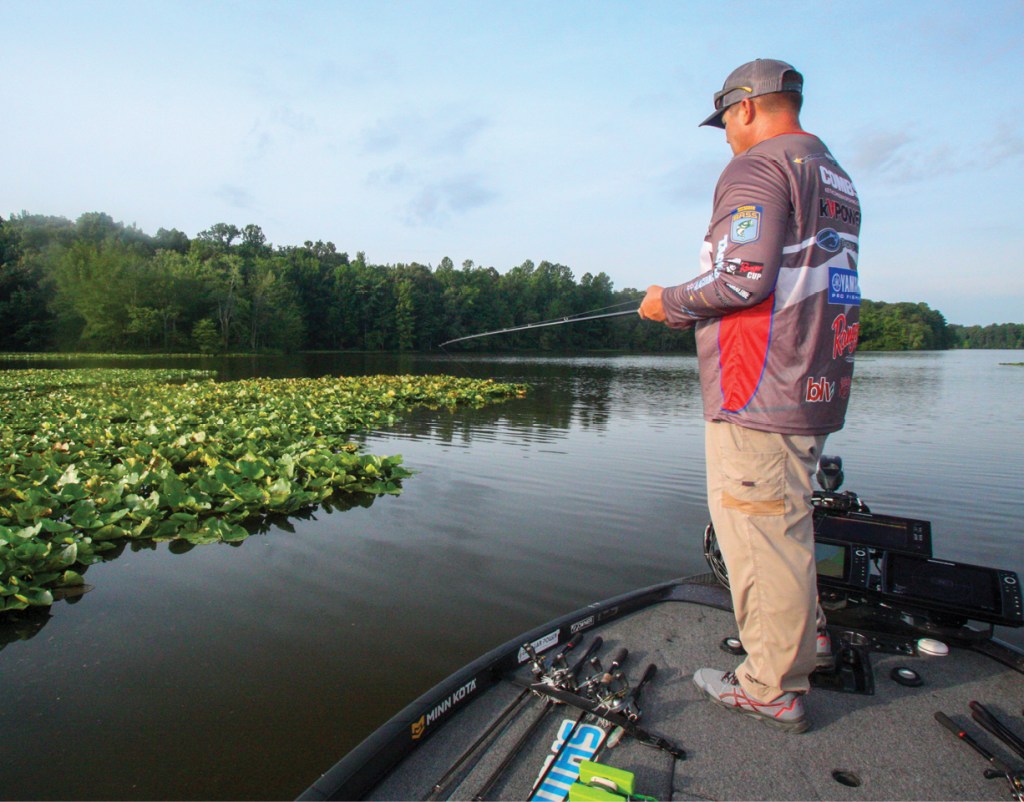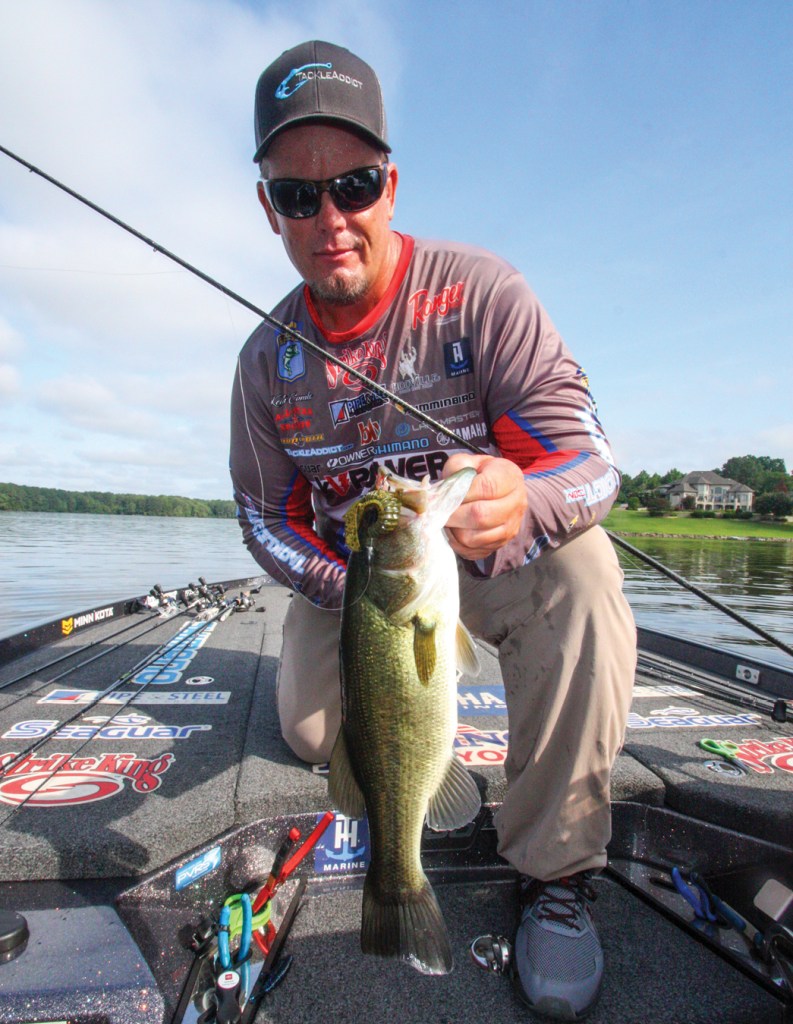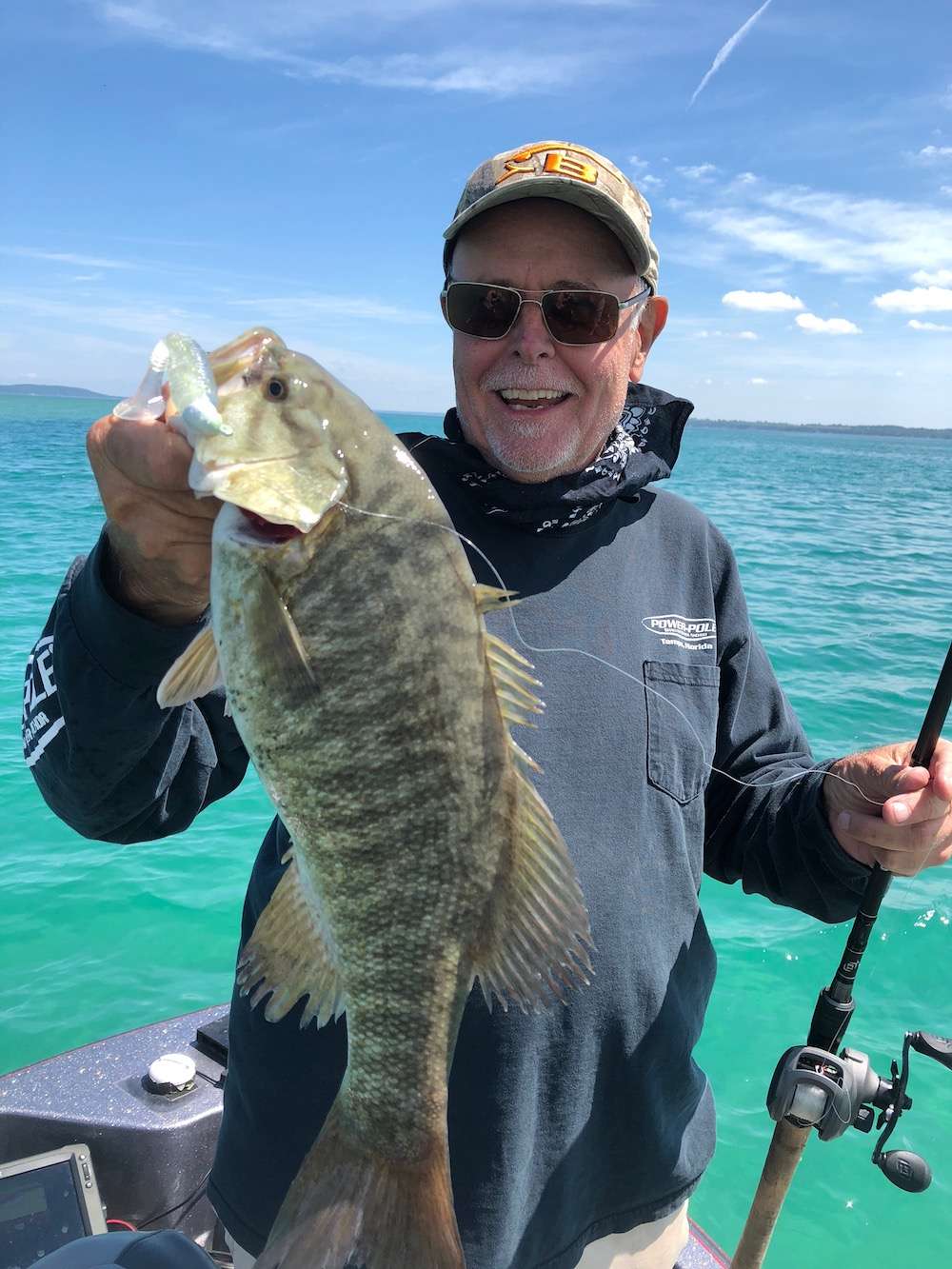In my opinion, Texas is the best bass fishing state in America. Here, 10-pounders are legion, there’s a bass boat in practically every garage and a “local” tournament on a lake like Sam Rayburn can easily draw several hundred boats and offer a five-figure first prize. Many veteran Lone Star anglers regard Keith Combs as the king of Texas bass fishing. Putting his prowess in top-tier B.A.S.S. events from New York to Michigan to California aside, Combs has won more Texas tournaments than you can shake a cranking stick at, which happens to be the tool he uses most often to rake in the winning bag. “Fishing is all I’ve ever done,” Combs admits. “I caught my first bass when I was 2 years old and was permanently hooked.” Combs played football in high school (he’s a big boy — he already stood 6-1 by the time he’d reached sixth grade) but confesses, “I really didn’t like it. I wanted to be fishing instead.” This lifelong obsession, combined with his relentless work ethic, has made Combs a superstar in his home state and one of the Elite Series’ most feared competitors. Here’s what happened when we put him on obscure Lake T on a hot July day.
• 6:19 a.m. It’s 68 degrees and clear when we arrive at Lake T’s boat launch. Combs prepares his arsenal of Shimano rods and reels; he’ll be fishing Strike King lures exclusively. What pattern does he anticipate today? “In late July, I’d normally expect reservoir bass to be mostly offshore, relating to baitfish schools,” he says. “But this region has had excessive rain, and the lake looks high, which could send some fish to the banks around newly flooded cover. Therefore, I’ll need to check both deep and shallow areas to get a handle on where the best bite will be.”
SEVEN HOURS LEFT
• 6:40 a.m. We launch the Ranger. Combs checks the water: It’s 84 degrees and stained. “My electronics are showing a submerged rockpile with fish on it close to the ramp. I’ll check that out before I take off on a scouting run.”
• 6:43 a.m. Combs makes his first casts of the day to the rockpile with a 9 1/2-inch melon bug-colored Zeus Worm, Texas-rigged with a 3/8-ounce sinker.
• 6:46 a.m. He switches to a chartreuse shad 5XD diving crankbait on the rocks. “Those fish look pretty small. They may be crappie.”
• 6:48 a.m. Combs reties the crankbait after detecting line abrasion from the rocks.
• 6:50 a.m. Back to the worm. “I bet this spot seldom gets fished. It’s close to the ramp, and most guys can’t wait to roar off right after launching.”
• 7 a.m. Combs idles 50 yards uplake, locates an offshore hump and grinds a chartreuse and blue 6XD crankbait across the structure. The lure hangs in fishing line, and he retrieves it with a plug knocker.
• 7:09 a.m. Combs drags the hump with the worm. “If I don’t catch anything here, I’ll probably check this spot again later. Summer bass will move on and off deep structures like this throughout the day.”
• 7:16 a.m. Combs runs farther uplake into a tributary arm with multiple moored pontoon boats (“they’re awesome overhead cover”). He begins working down the bank with a weedless green pumpkin surface frog.
• 7:20 a.m. Combs retrieves a 3/8-ounce chartreuse and white Thunder Cricket bladed jig with a pearl Blade Minnow trailer around the pontoons.
• 7:26 a.m. Pressing deeper into the tributary, Combs encounters thick emergent vegetation (“water willow”) and hits it with the frog and bladed jig. “This grass should hold bass in these high-water conditions.”
• 7:30 a.m. The creek arm holds thick fields of lily pads. On the bank Combs is fishing, they’re densely packed to within a couple feet of shore, then there’s a narrow band of open water. “That’s where the bass should be,” Combs says as he pitches the frog onto the bank and hops it into the lake.
• 7:34 a.m. Combs switches frog colors to green splatterback/white belly and crawls the faux croaker over the pads.

SIX HOURS LEFT
• 7:40 a.m. Combs is frustrated about the lack of irregularities in the pad field. “Bass normally concentrate around holes, boat lanes and thin spots in a pad field, but these pads are like one dense mass. I’d rather throw at one or two isolated pads than a hundred-yard carpet of solid pads.” Still, he patiently continues scooting the frog across the greenery.
• 7:46 a.m. Combs flips a 1/2-ounce black and blue jig with a matching chunk trailer into the pads. “They could be suspending under the pads with this high water.”
• 7:49 a.m. He rips the Thunder Cricket through a pocket in the outer edge of the pads “to provoke a reaction strike.” No takers, however.
• 7:51 a.m. Back to flipping the jig into the pads.
• 7:57 a.m. Picking up the pace, Combs grinds the bladed jig parallel to the pad field’s outer edge.
• 8 a.m. Combs casts the Thunder Cricket to an isolated pad patch but hauls water. “Should’ve been one there!”
• 8:04 a.m. Combs walks a crystal shad Sexy Dawg topwater stickbait across open water behind a pad patch. “I’m seeing a few small minnows breaking the surface but no bluegill or bass.”
• 8:10 a.m. Combs exits the pad field and moves to the mouth of the creek, where he roots a Tennessee shad-colored 1.5 squarebill crankbait around a seawall.
• 8:14 a.m. He moves to a nearby point and flips a massive laydown with the jig.
• 8:16 a.m. The point extends halfway across the lake and is riddled with stumps. Combs probes the structure with the 5XD and Zeus Worm. “This point has to be one of the key structural elements in this lake. I’m seeing some fish suspending around it on my forward-facing sonar, but they’re awfully small.”
• 8:21 a.m. No bites so far on the point. “They’ve got to stack up on this spot sooner or later! It’s got everything a summer bass wants: deep water close by, scattered cover, a hard bottom. I’m amazed I haven’t caught a fish here yet.”
• 8:24 a.m. A 10-inch gizzard shad jumps clear of the water near Combs’ boat. “I guarantee a big bass was chasing that shad!” He flings the 1.5 across the point but doesn’t connect with the elusive lunker.
• 8:28 a.m. Combs graphs a submerged brushpile adjacent to the point. He crawls the worm through the shrubbery, detects a peck, swings back his rod and misses the fish. “That felt more like a crappie nibble than a bass bite.”
• 8:33 a.m. Combs has fished the entire expanse of the point without success. “I’m going to run back downlake to hit some shallow stuff, but I’ll come back here later.”

FIVE HOURS LEFT
• 8:40 a.m. Combs is in the back of a residential cove, flipping a black and blue Rage Bug creature bait rigged with a 3/8-ounce pegged sinker and a 4/0 Owner Jungle hook around docks.
• 8:52 a.m. The cove doesn’t pan out, so Combs moves to a steep, main-lake channel bank and hammers several more docks with the Rage Bug.
• 8:57 a.m. A bass nips the claws off the creature under a dock. Combs replaces it with the same bait in green pumpkin and reflips the dock, but there’s no comeback.
• 9:09 a.m. Combs zips to a nearby tributary bank lined with water willows and flips the flooded cover with the creature.
• 9:10 a.m. Combs bags his first keeper bass of the day, a 2-pound, 4-ounce largemouth, on the Rage Bug. “This fish was right on the edge of the grass and bit the instant the lure hit the water. Emergent grass is perfect habitat for bluegill, minnows, crawfish, frogs and insects, and provides ample hiding and ambush places for bass.”
• 9:13 a.m. Continuing down the bank with the Rage Bug, Combs detects a bite and launches a 10-inch bass over his boat. “Whoa, sorry, buddy! I thought you were bigger!”
• 9:25 a.m. Halfway down the grassy bank, Combs swings at another fish and misses. “I wouldn’t exactly call this a world-class pattern, but I am getting some bites on it, and there’s no reason why some big fish wouldn’t be in this grass.”
• 9:34 a.m. He gets another bump on the Rage Bug and sets the hook, but the 1-pound fish comes un-
buttoned. “No great loss!”
FOUR HOURS LEFT
• 9:40 a.m. Combs moves to a submerged main-lake rockpile he’d graphed earlier and bags his second keeper, 1 pound even, on a 6-inch green pumpkin finesse worm rigged on a 3/16-ounce ball-head jig.
• 9:59 a.m. He catches a short fish off the brushpile.
• 10:07 a.m. Combs races to the mouth of another residential cove and flips the Rage Bug into a big patch of water willows. “There’s 12 feet of water right next to shore here, so they should be in this grass.”
• 10:09 a.m. Combs catches keeper No. 3, 1 pound, 5 ounces, from the grass on the creature. What’s his take on the day so far? “I’ve made a lap around two-thirds of the lake, and my only consistent bites have been in shoreline water willow. I’m not giving up on an offshore pattern, however; I know from experience that your best shot at catching some serious weight in summer is on main-lake structure. I’ll stick with the water-willow pattern until I catch a limit, then I’ll re-evaluate my game plan.”
• 10:19 a.m. Combs flips the Rage Bug into a thick patch of grass and catches his fourth keeper, 2 pounds, 10 ounces. “That’s a better fish, but I really need a couple of [7-pounders] to bump up my total!”
• 10:28 a.m. Combs has circled most of the cove while hitting flooded shoreline grass with the Rage Bug. He switches to a 3/8-ounce black and blue Pro Model buzzbait. “Topwater is a great option for a big fish in summer, and I’m needing a big fish bad!”
• 10:36 a.m. He catches his fifth keeper, 1-14, off a grass patch on the buzzer. “I’ve got my limit, and since the shallow bite seems to be picking up some, I’ll stick with this water-willow pattern a while longer.”

THREE HOURS LEFT
• 10:40 a.m. Combs resumes rounding the cove with the buzzbait.
• 10:49 a.m. He comes to a series of docks with scattered brushpiles around them. Neither the finesse worm nor the big worm inspires a bite.
• 11:06 a.m. Combs runs to Lake T’s extreme upper end, where the water is murkier and pads are the primary cover. He probes a pad field with a weedless frog without enticing a strike. “I’m starting to think the rising water has put the damper on the bass’ mood; I’ve hit some great-looking shallow and offshore places without any feedback whatsoever. Then again, it could be just a timing thing — maybe they’re feeding at night. One thing’s for certain: The more I fish, the less I know!”
• 11:22 a.m. Combs locates a 9-foot ditch near the pad field and probes it with the Zeus Worm and 5XD.
• 11:31 a.m. Combs moves into a nearby grassy pocket and catches his sixth keeper, 1-3, on the Rage Bug. “Believe it or not, this fish actually culls my second keeper.”
TWO HOURS LEFT
• 11:40 a.m. Several more minutes of flipping grass have proved unproductive, so Combs tries cranking the edge of the ditch with the 1.5.
• 11:47 a.m. He attacks a bank near an inflowing culvert with the buzzbait and Rage Bug.
• 11:54 a.m. Combs moves to a main-lake bank with the buzzbait. The noisy lure spooks a big carp off a shallow bar.
• Noon. Combs runs back downlake to the long, stumpy point he fished earlier. He stops in 20 feet of water and casts the 5XD and Zeus Worm to the shallow end of the structure. “This place is too choice-looking not to hold fish!”
• 12:13 p.m. It’s insufferably hot and muggy as Combs picks apart the point with the crankbait and worm. “This is exactly the kind of place I’d expect to find a big fish right now, but it just isn’t happening.”
• 12:29 p.m. He enters the tributary with pontoons, pads and grass that he fished earlier and targets water willows with the Rage Bug. “I feel like I’m missing something and it’s frustrating.”
ONE HOUR LEFT
• 12:40 p.m. Combs makes another downlake run, this time to the grassy bank where he caught his first keeper. Neither the Bug nor the buzzer produce another fish here.
• 12:51 p.m. Combs races to a rockpile he fished previously and drags the big worm down the craggy structure.
• 1:07 p.m. He runs back to the cove entrance where he caught two keepers earlier and walks the Sexy Dawg around water willows.
• 1:13 p.m. Combs’ creature sticks a bass in a sunken brushpile. It bolts for open water and shakes free. “Crap, that was a good fish!”
• 1:17 p.m. Combs dredges a Tennessee shad-colored 2.5 squarebill around a boathouse. “I’ve had no love around docks today.”
• 1:26 p.m. Combs races uplake to crank a mud point with the 5XD.
• 1:32 p.m. He spends his remaining minutes hitting a sunken brushpile with the Zeus Worm.
• 1:40 p.m. Time’s up! Combs finishes his day on Lake T with six keepers; his five biggest weigh
9 pounds, 4 ounces.
THE DAY IN PERSPECTIVE
“It was a grind out there today,” Combs tells Bassmaster. “Amazingly, the offshore bite was practically nonexistent — the points and rockpiles I fished should have held plenty of bass. The high water pushed some fish into shoreline water willows; that was the only consistent pattern I could find. If I were to fish here tomorrow, I’d start out hitting the grass with the buzzbait and maybe a swim jig, then once I had my limit, I’d try punching the pads with a heavy jig.”
WHERE AND WHEN KEITH COMBS CAUGHT HIS FIVE BIGGEST BASS
2 pounds, 4 ounces; Strike King Rage Bug (green pumpkin) with 3/8-ounce pegged sinker and 4/0 Owner Jungle hook; water willow in tributary; 9:10 a.m.
1 pound, 5 ounces; same lure as No. 1; water willow at cove mouth; 10:09 a.m.
2 pounds, 10 ounces; same lure as No. 1; water willow on cove shoreline; 10:19 a.m.
1 pound, 14 ounces; 3/8-ounce Strike King Pro Model buzzbait (black and blue); edge of water willow in cove; 10:36 a.m.
1 pound, 3 ounces; same lure as No. 1; water willow in shallow pocket; 11:31 a.m.
TOTAL: 9 POUNDS, 4 OUNCES





